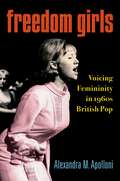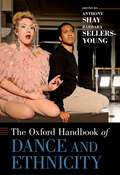- Table View
- List View
Music Composition For Dummies
by Holly Day Scott JarrettCreate the next big pop hit, bang out a catchy jingle, or write an iconic film score, with music composition skills Today's composers create music for television, film, commercials, and even video games. Music Composition For Dummies brings you up to speed with the theory and technicality of composing music. With easy-to-understand content that tracks to a typical music composition intro course, this book will teach you how to use music theory to write music in a variety of forms. You'll discover the latest tech tools for composers, including composing software and online streaming services where you can publish your musical creations. And you'll get a rundown on the world of intellectual property, so you can collab and remix fairly, while retaining all the rights to your own creations. Get a clear introduction to music theory and songwriting concepts Learn about composition best practices for movies, TV, video games, and beyond Explore sample music to help you understand both artistic and commercial composition Launch into the latest technologies to mix and share your creations Great for music students and aspiring artists, Music Composition For Dummies, is an easy-to-read guide to writing and producing all kinds of tunes.
Timpani Tone and the Interpretation of Baroque and Classical Music
by Steven L. SchweizerTimpani Tone and the Interpretation of Baroque and Classical Music explores the nature, production, and evolution of timpani tone and provides insights into how to interpret the music of J. S. Bach, Handel, Haydn, and Mozart. In drawing on 31 years of experience, Steven L. Schweizer focuses on the components of timpani tone and methods for producing it. In so doing, he discusses the importance of timpani bowl type; mallets; playing style; physical gestures; choice of drums; mallet grip; legato, marcato, and staccato strokes; playing different parts of the timpano head; and psychological openness to the music in effectively shaping and coloring timpani parts. In an acclaimed chapter on interpretation, Schweizer explores how timpanists can use knowledge of the composer's style, psychology, and musical intentions; phrasing and articulation; the musical score; and a conductor's gestures to effectively and convincingly play a part with emotional dynamism and power. The greater part of the book is devoted to the interpretation of Baroque and Classical orchestral and choral music. Meticulously drawing on original sources and authoritative scores from the seventeenth through nineteenth centuries, Schweizer convincingly demonstrates that timpanists were capable of producing a broader range of timpani tone earlier than is normally supposed. The increase in timpani size, covered timpani mallets, and thinner timpani heads increased the quality of timpani tone; therefore, today's timpanist's need not be entirely concerned with playing with very articulate sticks. In exhaustive sections on Bach, Handel, Haydn, and Mozart, Schweizer takes the reader on an odyssey through the interpretation of their symphonic and choral music. Relying on Baroque and Classical performance practices, timpani notation, the composer's musical style, and definitive scores, he interprets timpani parts from major works of these composers. Schweizer pays particular attention to timpani tone, articulation, phrasing, and dynamic contouring: elements necessary to effectively communicate their part to listeners.
Freedom Girls: Voicing Femininity in 1960s British Pop
by Alexandra M. ApolloniFreedom Girls: Voicing Femininity in 1960s British Pop shows how the vocal performances of girl singers in 1960s Britain defined-and sometimes defied-ideas about what it meant to be a young woman in the 1960s British pop music scene. The singing and expressive voices of Sandie Shaw, Cilla Black, Millie Small, Dusty Springfield, Lulu, Marianne Faithfull, and P.P. Arnold, reveal how vocal sound shapes access to social mobility, and consequently, access to power and musical authority. The book examines how Sandie Shaw and Cilla Black's ordinary girl personas were tied to whiteness and, in Black's case, her Liverpool origins. It shows how Dusty Springfield and Jamaican singer Millie Small engaged with the transatlantic sounds of soul and and ska, respectively, transforming ideas about musical genre, race, and gender. It reveals how attitudes about sexuality and youth in rock culture shaped the vocal performances of Lulu and Marianne Faithfull, and how P.P. Arnold has re-narrated rock history to center Black women's vocality. Freedom Girls draws on a broad array of archival sources, including music magazines, fashion and entertainment magazines produced for young women, biographies and interviews, audience research reports, and others to inform analysis of musical recordings (including such songs as "As Tears Go By," "Son of a Preacher Man," and others) and performances on television programs such as Ready Steady Go!, Shindig, and other 1960s music shows. These performances reveal the historical and contemporary connections between voice, social mobility, and musical authority, and demonstrate how singers used voice to navigate the boundaries of race, class, and gender.
The Oxford Handbook of Dance and Ethnicity (Oxford Handbooks)
by Anthony Shay and Barbara Sellers-YoungDance intersects with ethnicity in a powerful variety of ways and at a broad set of venues. Dance practices and attitudes about ethnicity have sometimes been the source of outright discord, as when African Americans were - and sometimes still are - told that their bodies are 'not right' for ballet, when Anglo Americans painted their faces black to perform in minstrel shows, when 19th century Christian missionaries banned the performance of particular native dance traditions throughout much of Polynesia, and when the Spanish conquistadors and church officials banned sacred Aztec dance rituals. More recently, dance performances became a locus of ethnic disunity in the former Yugoslavia as the Serbs of Bosnia attended dance concerts but only applauded for the Serbian dances, presaging the violent disintegration of that failed state. The Oxford Handbook of Dance and Ethnicity brings together scholars from across the globe in an investigation of what it means to define oneself in an ethnic category and how this category is performed and represented by dance as an ethnicity. Newly-commissioned for the volume, the chapters of the book place a reflective lens on dance and its context to examine the role of dance as performed embodiment of the historical moments and associated lived identities. In bringing modern dance and ballet into the conversation alongside forms more often considered ethnic, the chapters ask the reader to contemplate previous categories of folk, ethnic, classical, and modern. From this standpoint, the book considers how dance maintains, challenges, resists or in some cases evolves new forms of identity based on prior categories. Ultimately, the goal of the book is to acknowledge the depth of research that has been undertaken and to promote continued research and conceptualization of dance and its role in the creation of ethnicity. Dance and ethnicity is an increasingly active area of scholarly inquiry in dance studies and ethnomusicology alike and the need is great for serious scholarship to shape the contours of these debates. The Oxford Handbook of Dance and Ethnicity provides an authoritative and up-to-date survey of original research from leading experts which will set the tone for future scholarly conversation.



